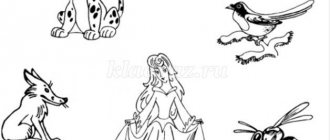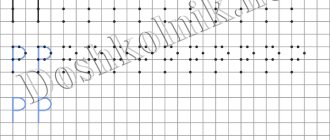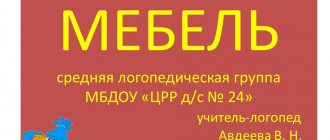Summary of an individual lesson on the topic: Automation of sound [R]
Topic: Sound automation [R].
Equipment: the hero Pinocchio, pictures for laying out objects according to a pattern, object pictures with the sound [P], a house for determining the place of a sound in a word, a match ball.
Program content:
Objectives: a) educational: to promote the enrichment of vocabulary; continue to learn to determine the place of the sound [P] in a word, form the diminutive form of nouns, coordinate a numeral with a noun, select correctly rhyming words in sentences; b) correctional: develop the articulatory apparatus; the ability to pronounce the sound [R] in isolation, in syllables, words, sentences, pure phrases; determine the positions of the organs of the speech apparatus when pronouncing the sound [P]; phonemic perception, visual and auditory attention, memory, motor skills; c) educational: to cultivate the desire and desire to help a friend; interest in achieving results from the work performed.
Preliminary work: articulatory gymnastics, sound production, sound automation in syllables, words, sentences were carried out; work on determining the position of sound in words, mastering the diminutive form of nouns, agreeing numerals with nouns.
Lesson plan:
I. Organizational moment. Setting up for the lesson.
II. Main part.
1. Articulation gymnastics. 2. Repetition of articulation of sound [P]. 3. Development of fine motor skills. 4. Repetition of pure sayings. 5. Working with subject pictures: a) “Name the word and determine the place of the sound”; b) “Call me affectionately”; c) “Count.” 6. Physical education minute. 7. Ball game “Finish the word.” 8. Game "Confusion".
III. Summarizing.
Progress of the lesson:
I. Organizational moment. Setting up for the lesson.
Tararam, tararam, Who is in a hurry to visit us? This boy is a friend of the guys, everyone will be glad to meet him! -Here is our guest - Pinocchio. He's very upset. His friends can speak well and pronounce sounds clearly. But Pinocchio has not yet learned to pronounce the sound [R]. Can you help our guest? After all, you have already learned how to pronounce this sound correctly. And for this you tried very hard and trained for a long time.
II. Main part.
1. Articulation gymnastics. - In order to quickly learn how to pronounce the sound [P], you need to remember and correctly perform the following exercises: - “Cup” - 5 sec. — “Mushroom” - 5 sec. - “Painter” - 5 times. - “Delicious jam” - 5 times. - “Horse” - 5 times. - “Motor” - 5-7 times. - “Drummers” - 5-7 times.
2. Repetition of sound articulation [R]: - Convey the growl of an angry dog, the croaking of a crow, the sound of a trumpet. — Tell Pinocchio about what lips, teeth, and tongue do when pronouncing the sound [R]. (Position of the speech organs: lips are open, teeth are open, the lateral edges of the tongue are pressed against the upper molars, the wide tip of the tongue is raised to the alveoli and vibrates).
3. Development of fine motor skills. Exercise “Lay out according to the pattern.” — Pinocchio brought pictures. Look and name the objects that are drawn on them. Lay out the matches according to the pattern. (Pictures: orange carrots, red fence, black rocket).
4. Repetition of pure sayings. Whoever wants to talk must pronounce clear words clearly, so that everyone can understand. -Let's teach Pinocchio to pronounce pure phrases with the sound [R]. RA-RA-RA-RU-RU-RU- frame, cancer, mountain. hands, guns, kangaroos.
RO-RO-RO-RY-RY-RY- Grove, mouth, feather. Fish, lynx, carpets.
AR-AR-AR- UR-UR-UR- Roma went to the market. Valera pulls the cord.
OR-OR-OR- YR-YR-YR- There is a carpet on the floor. There are many holes in the pocket.
5. Working with subject pictures. a) “Name the word and determine the place of the sound.” -Our guest brought an envelope with pictures. -Name the words and arrange them correctly: with the sound [P] at the beginning of the word, put it in the first window (etc.) (Subject pictures: rocket, shirt, fish, rose, drum, apron, watermelon, bed, tram, traffic light, tomato). b) “Call me kindly.” -Turn these words-objects into small ones (name them affectionately). For example: racket, rosette, etc. c) “Count.” -Now count the following items: rocket, drum, shirt (one rocket, two rockets,... five rockets, etc.).
6. Physical education minute. -Look, Pinocchio has cheered up a little. But there is one more problem - he lost his golden key. -While we are looking for the key, he will come up with an interesting game. “Pinocchio” (The child performs the appropriate movements).
Pinocchio stretched, Once - he bent down, Two - he bent down, He spread his arms to the sides, Apparently he couldn’t find the key. To get the key, we need to stand on our toes.
7. Ball game “Finish the word.” -This is the game Pinocchio came up with: RA-RA-RA The game begins. I ask you to help me name the words with the syllable RA! -I start the word, and you add RA: co-ra, game-ra, no-ra, uh-ra.
RO-RO-RO You finish with the syllable RO: ved-ro, good-ro, per-ro, silver-ro.
Now finish the words with the syllable RY: winds, mountains, mosquitoes, axes.
8. Game "Confusion". - And one more game: correct me if I mix up the words at the end of sentences. * Goats bloomed in the flowerbed, roses climbed into the garden. * A poppy crawls by the river, a crab blooms in the field. * I’ll stick a mask on the envelope, I’ll put a stamp on my face. * I'll take the cat from the cheese, I'll treat our crust.
III. Summarizing.
- Well done, you tried very hard today, so you clearly and clearly pronounced the sound [R] in syllables, words, pure phrases, and you taught this to Pinocchio. Our guest is grateful to you. Now you both watch your speech and don’t forget about the sound [R].
Author of the material: Mikhailenko Natalya Konstantinovna
Also on topic:
Summary of an individual lesson with a child with mental retardation
Progress of the lesson
Progress of an individual speech therapy lesson on sound automation [P]:
Organizing time
Good afternoon At previous classes, a red car came to us, this time it came not alone, but together with a tiger. Let's say hello to them. Today we will travel with them around Africa. First, let's go to Zanzibar, where all the residents love to do tongue exercises.
Articulation gymnastics
Each lesson on sound automation [P] begins with articulatory gymnastics:
- We smile wider, so that our teeth are visible.
(Fence - lips are open, stretched in a smile, teeth are closed).
- We will make mom happy - We will smile and kiss.
(Pipe-smile exercises alternate, each performed for 3 seconds).
- Our tongue will become a brush and quickly paint the fence.
(Let's brush the upper teeth - the mouth is slightly open, the tongue moves left and right, the lower jaw remains in a static position).
- The tongue has become a painter, Now he will paint the ceiling.
(Painter - the tip of a wide tongue should be moved back and forth across the sky).
- The cat licked the sponge and showed his tongue.
(Delicious jam - lick only the upper lip from top to bottom with a wide tongue, the mouth is open, the lower teeth do not support the tongue).
- We went for a walk in the forest together and found a mushroom there.
(Fungus - raise your wide tongue up, press it to the palate, open your mouth).
- And let's go play football, now we'll score a goal for everyone!
(Push the ball into the goal - blow cotton wool into the goal made of cubes with an air stream, stretching your lips forward. Do not puff out your cheeks).
- We click our tongues and stomp like horses.
(Horse - smile, open your mouth slightly, click your tongue on the roof of your mouth, the lower jaw should be motionless, if that doesn’t work, you can hold it with your hands).
- Like chattering turkeys, we will joke around together.
(Turkey - quickly move your tongue back and forth across your upper lip with a wide tongue, saying “bl-bl-bl”).
- Let's play a song about Antoshka on the harmonica.
(Accordion - “suck” a wide tongue to the palate, without letting go of the tongue to open and close the mouth).
- I love to drum: “D-d-d,” I tell everyone.
(Drum - open your mouth, smile, “knock” the alveoli with the tip of your wide tongue with the sound “D-d-d”).
Breathing exercises
Now we will take a swim in the Nile River.
To do this, take a glass of water from the river and a straw, and then blow to make bubbles.
Olga Bazhina
Speech therapist, project expert
Ask a Question
Development of phonemic hearing
The tiger lives in Savannah, he loves to run across the prairies and growl. His favorite sound, as you already guessed, is [R]. In addition, he really loves words with this sound. Help the tiger find and repeat them.
I will read phrases, and you name only those words that contain your favorite tiger sound.
A toothy crocodile, an Egyptian pyramid, an endless sea, Little Red Riding Hood, high mountains, a wide river, bright sun, peaceful sky, green grass, a narrow path, a long road, a fast cheetah, a long-necked giraffe, a hot day.
If necessary, explain to the child the meaning of unfamiliar words.
Automation of sound in phrasal speech
And now we have come to visit the tiger’s long-time good friend – the African elephant. This species of elephant is considered the largest in the world. He is also very smart and can even count. Let's count together with the elephant.
- One huge tiger, two huge tigers, five huge tigers;
- one pirate sail, two pirate sails, five pirate sails;
- one red gauntlet, two red gauntlets, five red gauntlets;
- one pair of roller skates, two pairs of roller skates, five pairs of roller skates.
Lesson summary
It's great to travel with new friends, but it's time to return home. We'll see the tiger, the red car and the African elephant next time.







